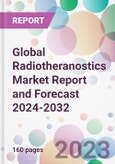The radiotheranostics market size was valued at USD 8.5 billion in 2023, driven by factors such as the increasing prevalence of cancer and advancements in molecular imaging and therapy across the globe. The market size is anticipated to grow at a CAGR of 13.5% during the forecast period of 2024-2032 to achieve a value of USD 26.7 billion by 2032.
Radiotheranostics involves two primary components: a diagnostic component and a therapeutic component. The diagnostic component utilizes molecular imaging techniques, such as positron emission tomography (PET), single-photon emission computed tomography (SPECT), or other imaging modalities, to detect and visualize specific molecular targets or biomarkers associated with the disease. This helps in accurate disease staging, monitoring treatment response, and identifying suitable candidates for radiotherapy.
North America currently dominates the radiotheranostics market, driven by the presence of well-established healthcare infrastructure, favourable reimbursement policies, and a high incidence of cancer. Europe is another significant market, with increasing adoption of radiotheranostics and advancements in molecular imaging technologies. The Asia Pacific region is expected to witness substantial growth due to rising healthcare expenditure, improving healthcare infrastructure, and increasing awareness of personalized medicine approaches.
Radiotheranostics: Introduction
Radiotheranostics, also known as theranostics or theragnostics, is an emerging field in medicine that combines therapeutic and diagnostic capabilities using radiopharmaceutical agents. It involves the use of radioactive materials or radiopharmaceuticals to both diagnose and treat diseases, particularly cancer. Radiotheranostics utilizes targeted radiation therapy, along with molecular imaging, to deliver personalized and precise treatments. This approach integrates diagnostic imaging and therapeutic interventions into a single modality, allowing for real-time monitoring of treatment response and personalized treatment strategies.Radiotheranostics involves two primary components: a diagnostic component and a therapeutic component. The diagnostic component utilizes molecular imaging techniques, such as positron emission tomography (PET), single-photon emission computed tomography (SPECT), or other imaging modalities, to detect and visualize specific molecular targets or biomarkers associated with the disease. This helps in accurate disease staging, monitoring treatment response, and identifying suitable candidates for radiotherapy.
Key Trends in the Global Radiotheranostics Market
The radiotheranostics market is experiencing significant growth and evolving with several key trends. These trends reflect advancements in technology, increased adoption of personalized medicine, and the growing demand for targeted therapies in the field of oncology. Some of the key trends in the radiotheranostics market include:
- Development of Novel Radiopharmaceuticals: The development of new radiopharmaceuticals is a major trend in the radiotheranostics market. Researchers and pharmaceutical companies are focusing on the discovery and development of novel radiotracers and therapeutic isotopes that can target specific molecular markers or biomarkers.
- Increasing Integration of Molecular Imaging and Therapy: Radiotheranostics involves the integration of molecular imaging and therapy into a single approach. There is a growing trend towards the seamless integration of diagnostic imaging techniques, such as PET and SPECT, with therapeutic interventions.
- Application Expansion Beyond Oncology: While oncology remains a primary focus of radiotheranostics, there is a trend towards exploring its applications in other disease areas. Radiotheranostics is being investigated for the treatment of neuroendocrine disorders, cardiovascular diseases, infectious diseases, and other conditions where molecular targets can be identified and targeted therapy can be applied.
- Adoption of Theranostic Platforms: Theranostic platforms that combine imaging and therapeutic capabilities are gaining popularity. These platforms facilitate efficient delivery of radiopharmaceuticals and enable simultaneous imaging and therapy.
- Growing Emphasis on Personalized Medicine: Radiotheranostics aligns with the principles of personalized medicine by tailoring treatment to individual patients. The trend towards personalized medicine, where treatments are customized based on a patient's specific characteristics and disease profile, is driving the demand for radiotheranostics.
Global Radiotheranostics Market Segmentations
The market can be categorised into radioisotope, applications, and region.Market Breakup by Radioisotope
- Radioisotope
- Iodine-131
- Iodine-123
- Gallium-68
- Lutetium-177
- 18F with Y-90
Market Breakup by Applications
- Oncology
- Non-Oncology
Market Breakup by Region
- North America
- Europe
- Asia Pacific
- Latin America
- Middle East and Africa
Global Radiotheranostics Market Overview
The radiotheranostics market is a rapidly growing segment within the broader field of molecular imaging and targeted therapy. Radiotheranostics combines diagnostic imaging and therapeutic capabilities using radiopharmaceuticals, enabling personalized and precise treatment approaches. Radiotheranostics offers personalized and targeted treatment approaches, particularly in the field of oncology. It enables the visualization of specific molecular targets or biomarkers through diagnostic imaging and delivers precise radiation therapy to the targeted sites for improved treatment outcomes.North America currently dominates the radiotheranostics market, driven by the presence of well-established healthcare infrastructure, favourable reimbursement policies, and a high incidence of cancer. Europe is another significant market, with increasing adoption of radiotheranostics and advancements in molecular imaging technologies. The Asia Pacific region is expected to witness substantial growth due to rising healthcare expenditure, improving healthcare infrastructure, and increasing awareness of personalized medicine approaches.
Key Players in the Global Radiotheranostics Market
The key features of the market report include patent analysis, grants analysis, clinical trials analysis, funding and investment analysis, partnerships, and collaborations analysis by the leading key players.The major companies in radiotheranostics market are as follows:
- Novartis AG
- Bayer AG
- Progenics Pharmaceuticals, Inc. (Lantheus)
- Telix Pharmaceuticals Limited.
- ITM Radiopharma
- Life Molecular Imaging.
- RadioMedix
- IsoTherapeutics Group, LLC
- Q BioMed Inc.
- Nordic Nanovector ASA
Table of Contents
1 Preface
3 Global Radiotheranostics Market Overview
4 Global Radiotheranostics Market Landscape
5 Global Radiotheranostics Market Dynamics
6 Global Radiotheranostics Market Segmentation
7 North America Radiotheranostics Market
8 Europe Radiotheranostics Market
9 Asia Pacific Radiotheranostics Market
10 Latin America Radiotheranostics Market
11 Middle East and Africa Radiotheranostics Market
12 Regulatory Framework
13 Patent Analysis
14 Grants Analysis
15 Clinical Trials Analysis
16 Funding and Investment Analysis
17 Partnership and Collaborations Analysis
18 Supplier Landscape
20 Company Competitiveness Analysis (Additional Insight)
21 Payment Methods (Additional Insight)
Companies Mentioned
- Novartis AG
- Bayer AG
- Progenics Pharmaceuticals Inc.(Lantheus)
- Telix Pharmaceuticals Limited.
- ITM Radiopharma
- Life Molecular Imaging.
- RadioMedix
- IsoTherapeutics Group LLC
- Q BioMed Inc.
- Nordic Nanovector ASA
Methodology

LOADING...








